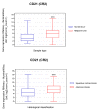Epstein-Barr Virus Infection in Lung Cancer: Insights and Perspectives
- PMID: 35215076
- PMCID: PMC8878590
- DOI: 10.3390/pathogens11020132
Epstein-Barr Virus Infection in Lung Cancer: Insights and Perspectives
Abstract
Lung cancer (LC) is the leading cause of cancer death worldwide. Tobacco smoke is the most frequent risk factor etiologically associated with LC, although exposures to other environmental factors such as arsenic, radon or asbestos are also involved. Additionally, the involvement of some viral infections such as high-risk human papillomaviruses (HR-HPVs), Merkel cell polyomavirus (MCPyV), Jaagsiekte Sheep Retrovirus (JSRV), John Cunningham Virus (JCV), and Epstein-Barr virus (EBV) has been suggested in LC, though an etiological relationship has not yet been established. EBV is a ubiquitous gamma herpesvirus causing persistent infections and some lymphoid and epithelial tumors. Since EBV is heterogeneously detected in LCs from different parts of the world, in this review we address the epidemiological and experimental evidence of a potential role of EBV. Considering this evidence, we propose mechanisms potentially involved in EBV-associated lung carcinogenesis. Additional studies are warranted to dissect the role of EBV in this very frequent malignancy.
Keywords: Epstein–Barr virus; cancer; lung.
Conflict of interest statement
The authors declare no conflict of interest.
Figures




References
-
- Reis-Filho J.S., Simpson P.T., Martins A., Preto A., Gärtner F., Schmitt F.C., Archiv V. Distribution of p63, cytokeratins 5/6 and cytokeratin 14 in 51 normal and 400 neoplastic human tissue samples using TARP-4 multi-tumor tissue microarray. Virchows Arch. 2003;443:122–132. - PubMed
Publication types
LinkOut - more resources
Full Text Sources

